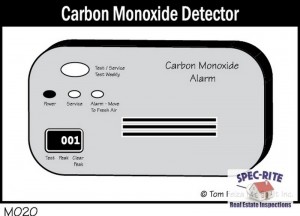Carbon Monoxide Detectors – New Requirements in California
 During my inspection duties, I’m asked quite often about where and what the requirements are for Carbon Monoxide detectors. It would seem that after a year and a half now there’s some confusion, let’s clear it up!
During my inspection duties, I’m asked quite often about where and what the requirements are for Carbon Monoxide detectors. It would seem that after a year and a half now there’s some confusion, let’s clear it up!
Where are Carbon Monoxide Detectors Required in my Residence?
On May 7, 2010 our California Senate passed Senate Bill 183 or (SB) 183 called the “Carbon Monoxide Poisoning Prevention Act” which applies to all existing and newly constructed housing. In a nutshell, Carbon Monoxide Detectors are required in all Homes (single‐family dwelling, factory‐built homes, duplex, lodging house, condominiums, motels,hotels, dormitories, stock cooperatives, time‐share projects and dwelling units in “multiple‐unit dwelling unit buildings” (apartment houses).
- As of today, all homes that have a Fossil Fuel appliance (appliance, furnace, fireplace etc) a fossil fuel is pretty much everything that’s not electricity natural gas, fuel oils, kerosene, LP etc.
- Carbon Monoxide Detectors should be installed ON EACH FLOOR and adjacent to the sleeping areas. That can mean more than one per floor, if for example the Master Bedroom and Guest Room are on opposite sides of the first or second floor of home (over 40 feet) and there is an additional sleeping area downstairs.
- Interconnected Devices – Now here is a tricky one that I haven’t heard of being enforced or called out yet. My opinion is that if the home already has hard-wired smoke detectors, the installation of the Carbon Monoxide detectors should be interconnected as well, yet Carbon Monoxide is heavier-than-air. Who thinks of this stuff??
- Interconnected Devices R315.1.3 Interconnection. Where more than one carbon monoxide alarm (2 story’s etc) is required to be installed within the dwelling unit or within a sleeping unit the alarm shall be interconnected in a manner that activation of one alarm shall activate all of the alarms in the individual unit.
- Exceptions:
- 1. Interconnection is not required in existing dwelling units where repairs do not result in the removal of wall and ceiling finishes, there is no access by means of attic, basement or crawl space, and no previous method for interconnection existed.
- 2. In existing dwelling units, carbon monoxide alarms are not required to be interconnected where no construction is taking place.
Next up, all apartment (multi family) buildings will require Carbon Monoxide Detectors as of January 1, 2013

[…] For Safety and to save lives is the simple answer. Also, the building code has been written and expounded upon many times over in an effort, to ensure these devices are installed in all sleeping areas as well as adjoining areas/hallways. Plainly spoken, the state and local municipalities have made efforts to ensure that homes that didn’t originally have smoke detectors, end up with them in all currently required installation locations. It would be difficult to make a case for most any home/dwelling to not have a smoke detector, and now a Carbon Monoxide detector. […]